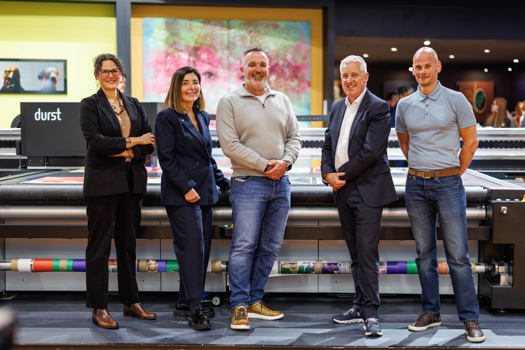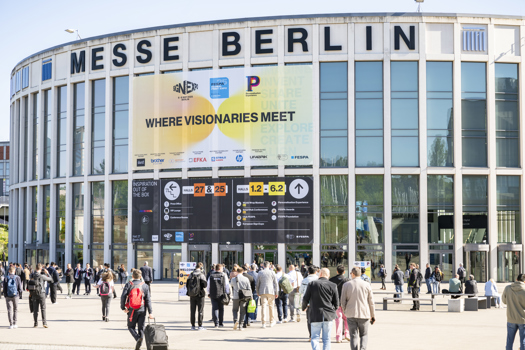What does the machine do?
HP’s Indigo 7000 series has always been the high-speed high-volume press for SRA3 cut-sheet applications. Until the bigger B2 10000 was launched at Drupa 2012 it was the firm’s flagship sheetfed machine.
When was it launched and what market is it aimed at?
This June HP announced the 7800, a new top-of-the-range SRA3 machine, which replaces the 7600. It is aimed at printers who have volumes needing its high throughput but don’t need a bigger sheet. According to HP Indigo EMEA business manager Montserrat Peidro-Insa the target markets are general commercial printers, photo printers and publications printers.
How does it work?
Like all the Indigo machines it uses HP’s ElectroInk liquid toner technology. All toner-based machines use lasers to write the image. The key difference is that the colorants are suspended in liquid rather than as a dry powder, which means the resulting prints look more like those produced by conventional inks.
How does it differ from previous models?
Inside the 7800 are a combination of new features and existing technology from both the 10000 and the 5600 that 7000 series customers had been asking for to improve quality, productivity and application range. From the 10000 the 7800 gets its on-press inline spectrophotometer, while from the 5600 it gets the one-shot printing option.
“In one-shot mode all the colours are assembled on the blanket and then transferred to the substrate in ‘one shot’,” says product manager Raúl Mambrilla.
“There are three advantages: for heat-sensitive materials it prevents registration issues, on delicate material it reduces the chance of scratches and for photo applications it ensure extremely tight registration for the highest quality and sharpness.”
There’s no speed penalty in one-shot mode, but it does result in an increased click charge of around 50%. “It’s only justifiable for high-value applications and substrates,” says Mambrilla.
The spectrophotometer carries out a number of functions. As it’s in the press it can automatically create a substrate profile for a new stocks, which can then be shared with any other Indigo. “This is a big aid for smaller firms that can’t afford to employ a colour specialist,” says Peidro-Insa.
It can also be used to ensure that the press matches a common standard, enabling colour matching across multiple presses, sites and even companies, if work is being outsourced or shared by a network of printers. It can also be used to check and adjust colour to make sure it is to spec. Lastly, it can be used to produce a report on the colour conformance of a job.
How fast/productive is it?
The mechanical speed of the press is unchanged at 120 A4 ppm, but HP says the productivity benefits come from the new features that improve uptime and reduce the need for intervention, such as the spectrophotometer and Smart Scheduling.
“It’s like having a very smart production manager in the press,” says Peidro-Insa.
Smart Scheduling analyses the jobs in the queue and reorganises them by substrate, sheet size, colour, and print mode. HP claims that by minimising changeovers it can increase productivity by 50%.
There’s also the EPM option, which produces a 33% speed increase and lower costs over conventional CMYK by dropping the black ink. It’s the opposite of UCR/GCR.
What is the USP of the machine?
Versatility – the 7800 is as happy churning out volume work flat-out on standard stock as it is producing added-value work using the range of special colours and printing effects on challenging textured, synthetic and metallic substrates.
HP is also keen to highlight the eco credential of the press. New on the 7800 is the regeneration of the imaging oil, eliminating the need to top up the oil and safely dispose of the waste. All Indigos are now supplied with the carbon footprint of their production offset.
How easy is it to use?
The inline spectro reduces the need for in-depth colour expertise for the operator.
How much does it cost?
A basic machine starts at £575,000. Field upgrades are also available for existing 7000 series machines starting from £50,000.
How many are installed?
ProCo in Sheffield got the UK’s first, following German photo firm Cewe, which got Europe’s first. Several existing 7000 series users have ordered the upgrade, and those will begin to be rolled out early next year.
SPECIFICATIONS
Max sheet size 330x482mm
Speed 120 A4 ppm (CMYK), 160 A4 ppm (EPM/CMY)
Max number of colours 7
Stock weight range 60-350gsm
Price From £575,000, Upgrades to 7000 series from £50,000
Contact HP 0330 587 5113 www.hp.com
ALTERNATIVES
Kodak NexPress SX3900
Kodak kicked off special effects in digital several years ago using the fifth unit for special effects and security features. A long-sheet option handles stocks up to 914mm long for leaflets of up to 8pp. The NexPress range is modular, meaning users can start with a slower machine and upgrade as volumes increase. Enhanced productivity and lower cost modes are available. Kodak offers a toner-only pricing model, rather than a click charge, for more flexibility.
Max sheet size 356x520mm (standard), 356x914mm (optional)
Speed 120 A4 ppm (131ppm with long-sheet option
Number of colours 5
Stock weight range 60-350gsm
Price £320,000
Contact Kodak 0845 602 5991 www.kodak.com
Xerox iGen150
At 150 A4 ppm, the iGen 150 is the fastest of the SRA3 machines in CMYK. There are no additional units for special effects or colours, so it’s more suited to high-volume applications rather than added-value work. The long-sheet option enables sheets up to 660mm long to be used for 3-up A4 production.
Max sheet size 364x660mm
Speed 150 A4ppm
Number of colours 4
Stock weight range 60-350gsm
Price From £500,000
Contact Xerox 0330 123 3245 www.xerox.co.uk
USER REVIEW
“The 7800 gives us extra – not just volume and capacity, but also an edge in new applications. EPM is really good and we’re also moving a lot of work onto the 7800 because of improved colour” 5/5
Jon Bailey, managing director, ProCo









